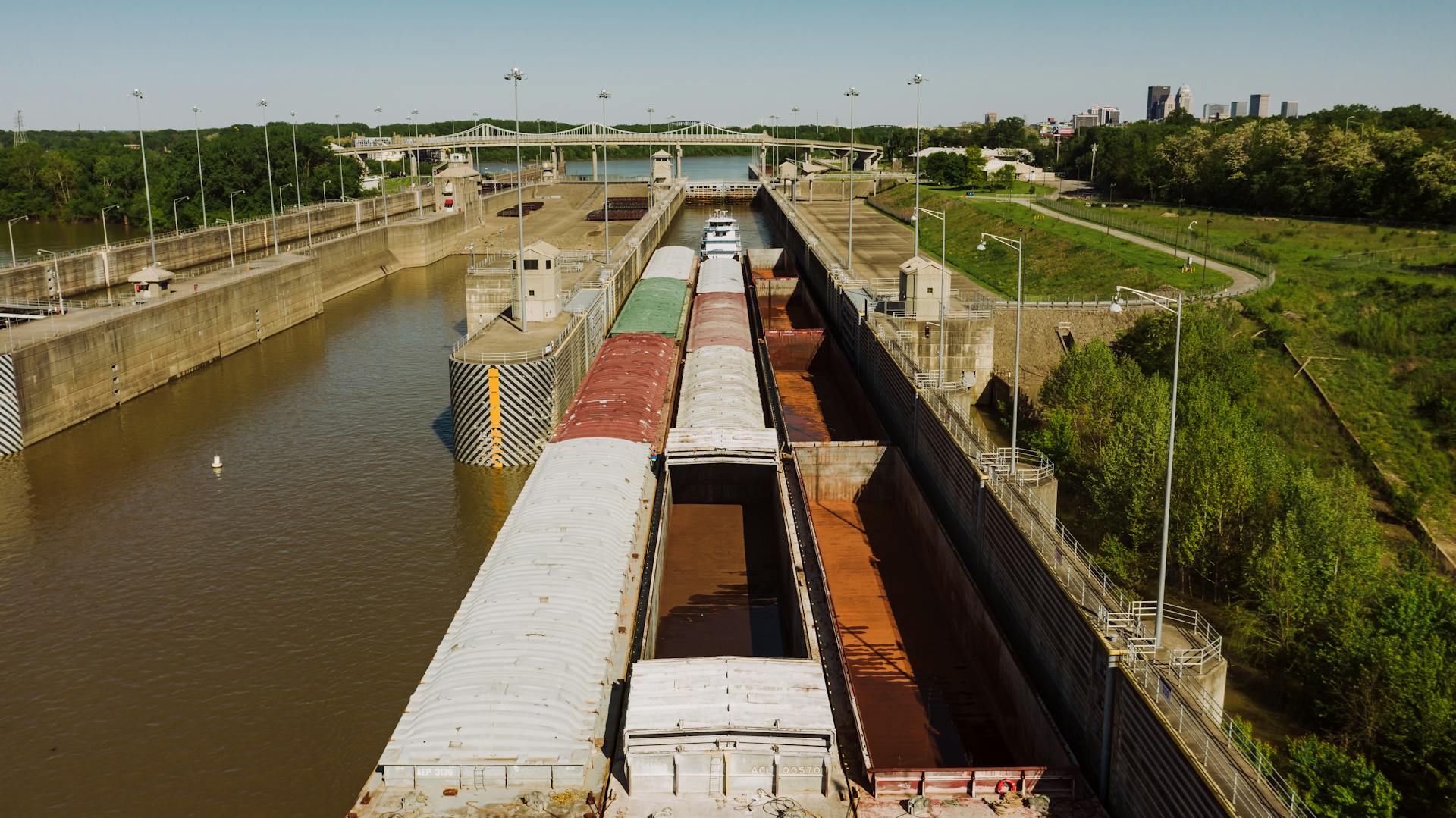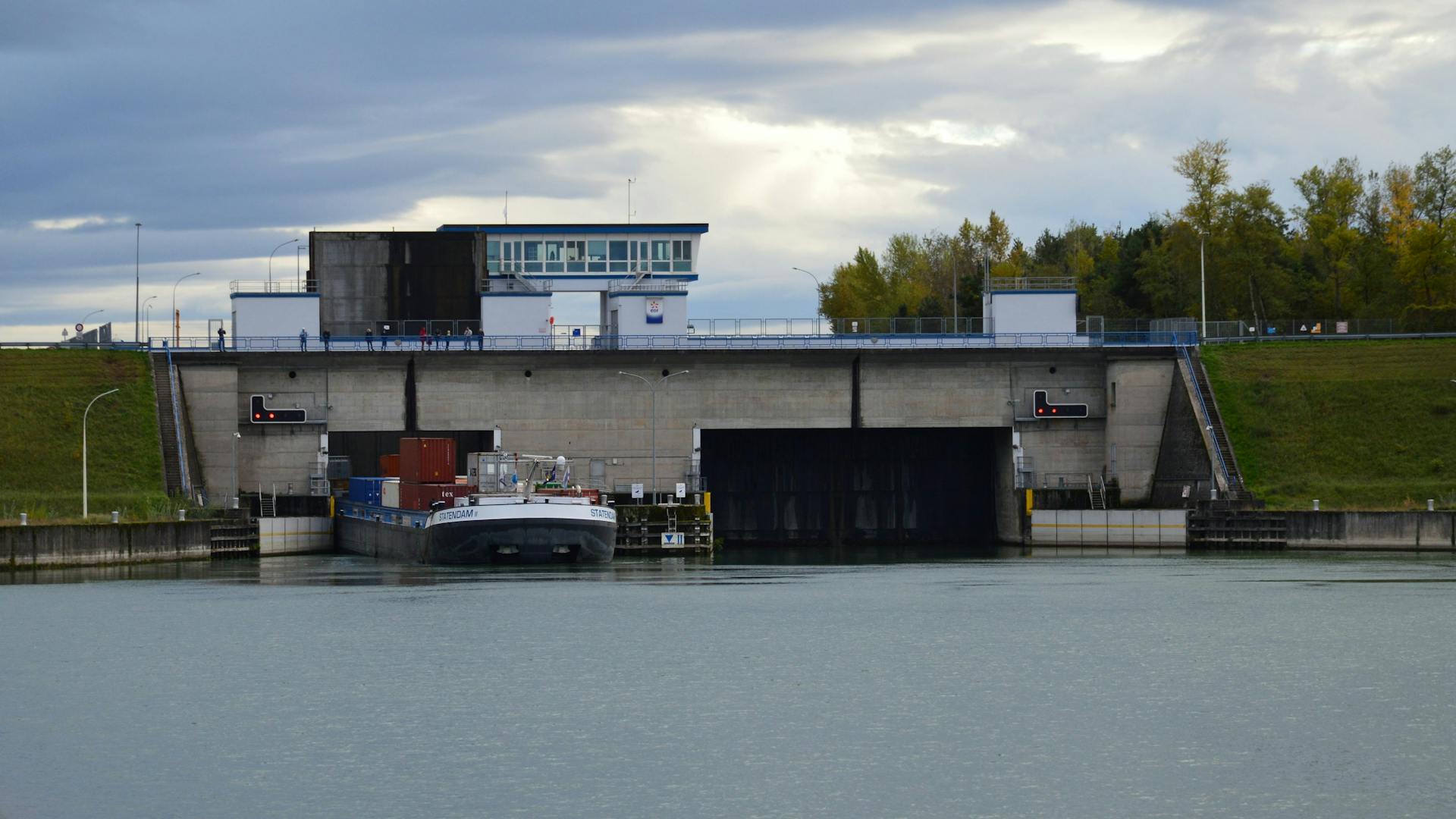
The United States has a vast network of container ports that play a crucial role in its economy.
The country's container ports can be broadly categorized into five regions: the East Coast, the Gulf Coast, the West Coast, the Great Lakes, and Hawaii.
The East Coast region is home to some of the busiest container ports in the country, including the Port of New York and New Jersey, which handled over 7 million containers in 2020.
The Gulf Coast region, on the other hand, is known for its oil and gas exports, with the Port of Houston being a major hub.
The West Coast region is dominated by the Port of Los Angeles and the Port of Long Beach, which together handle over 40% of the country's containerized cargo.
Hawaii's container ports, such as the Port of Honolulu, are strategically located to serve the Pacific Islands and the mainland United States.
The Great Lakes region has a smaller but still significant number of container ports, including the Port of Chicago and the Port of Detroit.
United States Container Ports
The United States is home to a vast network of container ports that play a crucial role in the country's economy.
Los Angeles and Long Beach, California, are the busiest container ports in the US, handling over 17 million containers in 2020.
The Port of New York and New Jersey is another major player, with cargo volumes reaching 7.2 million containers in 2020.
The Port of Savannah in Georgia is a key hub for the Southeast, with 4.8 million containers passing through in 2020.
The Port of Oakland in California is a major gateway for Asian trade, with 2.4 million containers handled in 2020.
These ports are critical for the US economy, with the container shipping industry supporting over 23 million jobs and generating $4.6 trillion in economic activity.
West Coast
The West Coast is home to some of the busiest and most efficient container ports in the United States. The Port of Seattle has a draft depth of 50 feet and unlimited air draft, making it a popular choice for large ships.
The Port of Tacoma also has a draft depth of greater than 50 feet and unlimited air draft, offering flexibility for various types of vessels. In contrast, the Port of Portland has a draft depth of 40 feet and an air draft of 196 feet.
The Port of Oakland and the Port of San Francisco both have a draft depth of 50 feet and an air draft of 220 feet, making them suitable for larger ships. The Port of Hueneme, on the other hand, has a draft depth of 40 feet and unlimited air draft.
Here's a list of the West Coast ports mentioned, along with their draft depths and air drafts:
The Port of Los Angeles has a draft depth of greater than 52 feet and unlimited air draft, while the Port of Long Beach has a draft depth of greater than 50 feet and unlimited air draft. The Port of San Diego has a draft depth of greater than 35 feet and unlimited air draft.
Major Ports on the Gulf Coast
The Gulf Coast is home to several major ports that play a crucial role in the United States' container trade. The Port of Houston has a draft depth of 45 feet, making it suitable for large vessels, while the Port of New Orleans has an air draft of 170 feet, allowing for even the tallest ships to pass through.
Here are some of the major ports on the Gulf Coast, along with their draft depths and air drafts:
These ports offer a range of services, including extensive berthing space, warehouses, and rail and road connections, making them ideal for cargo movement. The Port of Freeport, for example, is a major deep-water port serving the Gulf Coast region, while the Houston Port is one of the busiest ports in the United States.
Gulf Coast
The Gulf Coast is home to some of the busiest and most important ports in the United States. The Port of Houston is a major seaport with a draft depth of 45 feet (14 m) and unlimited air draft.
One of the busiest ports in the country, the Port of Houston Authority handles a wide range of cargo, including petroleum and chemicals. With state-of-the-art facilities and a strategic location along the Gulf of Mexico, it's a crucial hub for international trade and commerce.
Here's a breakdown of some of the major ports on the Gulf Coast:
The Port of New Orleans is another major player on the Gulf Coast, with a draft depth of 45 feet (14 m) and an impressive air draft of 170 feet (52 m). The Alabama State Port Authority operates the Mobile Port, which is a crucial hub for both domestic and international trade.
The Gulfport Port in Mississippi is a riverport with a draft depth of 39 feet (12 m) and unlimited air draft. It's a major seaport handling various cargo types, including containers, bulk, and general cargo.
The Tampa Port Authority operates the Tampa Port, which is Florida's largest port by tonnage and one of the nation's top cargo ports. It boasts modern facilities equipped to handle diverse cargo types, from containerized goods to petroleum products.
Orleans (Louisiana)
The New Orleans Port in Louisiana is a major hub for maritime commerce and trade, serving as a crucial gateway for both domestic and international shipping.
Located along the Mississippi River, its strategic position allows for easy access to inland waterways and transportation networks, facilitating the movement of goods to and from the Gulf of Mexico.
The port is situated at 1350 Port of New Orleans Place, New Orleans, LA 70130, United States.
The Board of Commissioners of the Port of New Orleans oversees the port's operations.
The New Orleans Port is one of the busiest ports in the nation, with extensive facilities including container terminals, bulk cargo handling, warehouses, and advanced logistics infrastructure.
This infrastructure supports diverse industries such as agriculture, petrochemicals, and manufacturing.
Major Ports on the East Coast
The East Coast is home to some of the busiest and most important container ports in the United States.
The Port of New York and New Jersey, located in New York, is the third-largest port in the country, handling over 7.5 million TEUs in 2020. It boasts an operating capacity of approximately 9 million TEUs and serves as the first port of call for over 70% of the world's major ocean carriers and global alliances.
Some of the major East Coast ports include the Port of Miami, Port Everglades, and Port of Jacksonville, all of which have draft depths ranging from 36 to 52 feet. The Port of Savannah has a draft depth of 47 feet and an air draft of 185 feet, while the Port of Charleston has a draft depth of 52 feet and an air draft of 186 feet.
Here are some of the key East Coast ports and their draft depths:
The Port of Baltimore has a draft depth of 50 feet and an air draft of 185 feet, while the Port of Wilmington (Delaware) has a draft depth of 38 feet and an air draft of 188 feet.
East Coast
The East Coast is home to some of the busiest and most significant ports in the world. The Port of New York and New Jersey is the third-largest port in the US, handling over 7.5 million TEUs in 2020.
Port Everglades and the Port of Miami both have a draft depth of 43 feet, making them suitable for a wide range of vessels. The Port of Charleston, on the other hand, has a draft depth of 52 feet, allowing it to accommodate even the largest container ships.
The Port of Virginia is a crucial hub for international trade, with a throughput of over 2.8 million TEUs in 2020. The Port of Baltimore is another significant player, handling various cargo types, including containers, automobiles, and bulk commodities.
Here's a list of some of the major ports on the East Coast, along with their draft depths and air drafts:
The Port of Charleston is a growth leader, recognized as the fastest-growing container port in the US. It has invested heavily in its infrastructure, including the newly operational Hugh Leatherman Terminal.
Wilmington, Delaware
Wilmington, Delaware, is a key maritime hub along the Delaware River.
Located strategically close to major metropolitan areas like Philadelphia and Baltimore, Wilmington Port offers efficient transportation links to the East Coast market.
The Port of Wilmington is equipped with modern facilities and infrastructure, including deepwater berths and extensive storage capacities.
As a versatile port, it accommodates various cargo types, including containers, bulk commodities, and petroleum products.
Wilmington Port efficiently handles both domestic and international trade, contributing significantly to the regional economy and global supply chain networks.
Global Supply Chain Interruption
The global supply chain interruption in 2020 was a huge challenge for industries around the world. Industries shutdown due to the rapid spread of the virus, leading to reduced industrial activity and lower consumer demand.
The ports of Long Beach and Los Angeles, which account for approximately 40% of the shipping containers entering the United States, were particularly impacted. In July 2021, more than three-quarters of the containers leaving Los Angeles were empty, whereas about two-thirds of the containers leaving U.S. ports are typically filled with exports.
This was due in part to the rush by shippers to bring in imports of back-to-school supplies and fall fashions from Asia. As a result, Midwestern farmers and California Almond Growers who ship to customers overseas were affected.
Shipping companies placed a lower priority on products that paid lower shipping rates, resulting in various exports being delayed. This led to a record number of ships at the docks of the Los Angeles area ports and a record number of ships waiting for a slip in October.
Here are some key statistics on the backlog at U.S. ports:
- Total value of trade stuck on the water off the east and west coast ports was estimated at roughly $30 billion by July 2022.
- $1.5 billion in trade was waiting for rail service at the Ports of Long Beach and Los Angeles, which was 60% of all containers waiting at these ports.
- By September 2022, the backlog at U.S. ports decreased partially due to slowing U.S. import volumes amid high inflation and rising interest rates.
Top 10 Shipping
The top shipping ports in the United States are ranked by the U.S. Department of Transportation using a standard unit of measurement called TEUs (Twenty-foot Equivalent Units). This allows for consistent comparison across ports.
To determine the busiest and most efficient ports, several key factors are considered. Strategic location is a major factor, with ports near major trade routes handling higher cargo volumes and reducing transit times.
Ports with modern equipment, deepwater docks, and technologies like automated container tracking and freight tracking software significantly enhance operational efficiency. This is crucial for ports that need to handle massive cargo volumes efficiently.
A high TEU capacity is a key metric of a port's success, and it signifies the port's ability to manage massive cargo volumes efficiently. The busiest shipping ports in the U.S. are ranked by their TEU traffic.
Here are the top 10 shipping ports in the U.S. based on TEU traffic:
Frequently Asked Questions
What is the busiest US port of entry?
The busiest US port of entry is the Port of Los Angeles, California, also known as "America's Port." It's the largest container port in the US, handling a massive volume of international trade.
How many US ports are foreign owned?
According to MundoMaritimo, approximately 80% of U.S. ports are foreign-owned, with most major terminals controlled by overseas companies. This raises concerns about national security and economic influence.
Sources
- https://en.wikipedia.org/wiki/United_States_container_ports
- https://www.zenddu.com/main-container-ports-in-the-united-states/
- https://www.vizionapi.com/blog/top-shipping-ports-united-states
- https://orbitshub.com/the-10-biggest-and-busiest-container-ports-in-the-us/
- https://www.globaltrademag.com/top-25-container-ports-in-the-united-states/
Featured Images: pexels.com


